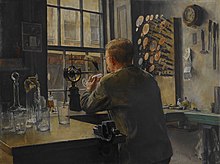
Engraved glass is a type of decorated glass that involves shallowly engraving the surface of a glass object, either by holding it against a rotating wheel, or manipulating a "diamond point" in the style of an engraving burin. It is a subgroup of glass art, which refers to all artistic glass, much of it made by "hot" techniques such as moulding and blowing melting glass, and with other "cold" techniques such as glass etching which uses acidic, caustic, or abrasive substances to achieve artistic effects, and cut glass, which is cut with an abrasive wheel, but more deeply than in engraved glass, where the engraving normally only cuts deeply enough into the surface to leave a mark. Usually the engraved surface is left "frosted" so a difference is visible, while in cut glass the cut surface is polished to restore transparency. Some pieces may combine two or more techniques.

There are several different techniques of glass engraving. It has been practised since ancient times, including Roman glass, and professionally engraved glass has always been an expensive luxury, requiring lavish amounts of labour by a highly skilled craftsman or artist. In recent centuries the most notable periods and places of production started in the 16th century, initially mostly in Venetian glass, then later in Germany and Bohemian glass. From about 1645 it was used in the Netherlands, which was producing the finest engraving by 1700, by which time some engraving was used in most glass-making centres in Europe. The late 17th and early 18th centuries were in some ways the peak period of achievement and popularity. From 1730 onwards it received some competition from the new geometric cut glass style developed in England. These related techniques were often combined in a single piece, but the engraving tended to be relegated to less prominent positions.
In the 19th century cut glass continued to dominate, and new techniques of etched glass, cheaper than engraving, also took some of the role formerly occupied by engraving. By the later part of the century, a whole variety of techniques, many including coloured glass, had developed. Engraved glass retained some niches, and was sometimes used in art glass and later studio glass, but no longer had its former importance, although there has been a revival in Britain, with many public commissions for large window-size pieces.
Much glass remains in private collections, and many museums do not display much of their holdings, and often do not display them to the best advantage, which is usually against a dark background. Wineglasses were meant to be appreciated by holding in the hand, and when full any distracting engraving on the other side of the glass was not visible, or much less so.[1]
- ^ Norman, 50
© MMXXIII Rich X Search. We shall prevail. All rights reserved. Rich X Search
